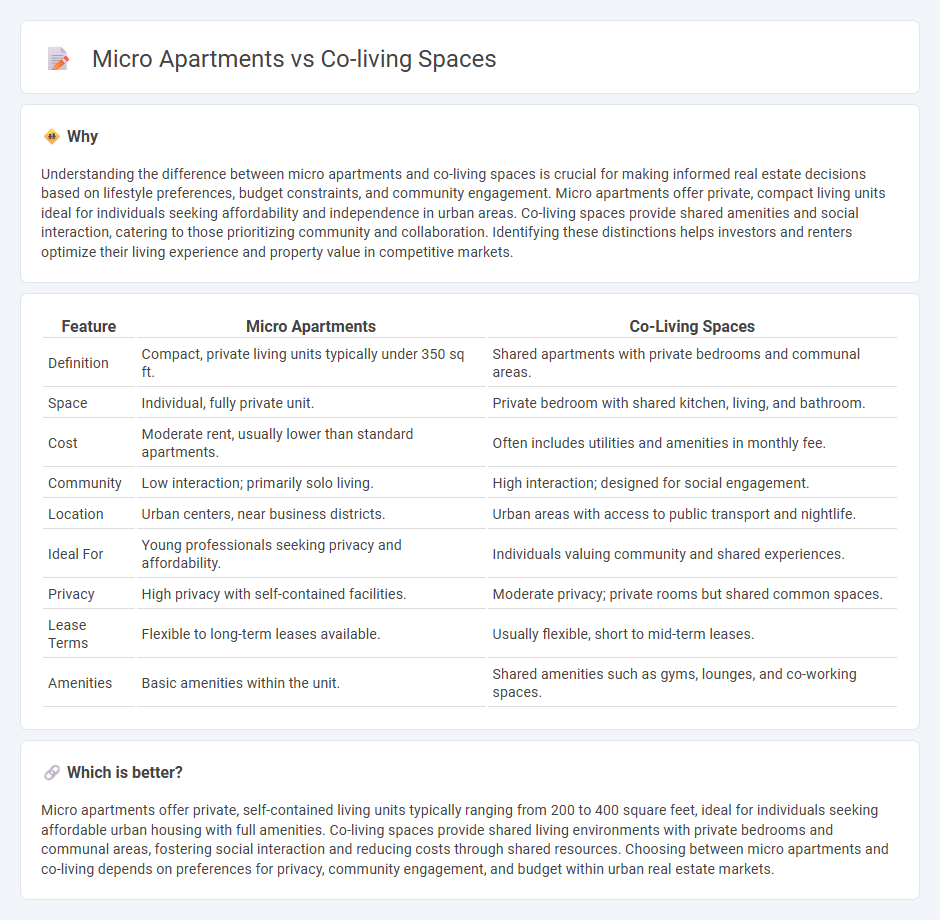
Micro apartments offer compact, self-contained living units ideal for urban dwellers seeking affordable privacy, while co-living spaces provide shared amenities and a community atmosphere tailored to social professionals and remote workers. Both housing options address the rising demand for flexible, cost-effective urban living solutions amidst limited city real estate. Discover the key differences to find the right fit for your lifestyle and investment goals.
Why it is important
Understanding the difference between micro apartments and co-living spaces is crucial for making informed real estate decisions based on lifestyle preferences, budget constraints, and community engagement. Micro apartments offer private, compact living units ideal for individuals seeking affordability and independence in urban areas. Co-living spaces provide shared amenities and social interaction, catering to those prioritizing community and collaboration. Identifying these distinctions helps investors and renters optimize their living experience and property value in competitive markets.
Comparison Table
| Feature | Micro Apartments | Co-Living Spaces |
|---|---|---|
| Definition | Compact, private living units typically under 350 sq ft. | Shared apartments with private bedrooms and communal areas. |
| Space | Individual, fully private unit. | Private bedroom with shared kitchen, living, and bathroom. |
| Cost | Moderate rent, usually lower than standard apartments. | Often includes utilities and amenities in monthly fee. |
| Community | Low interaction; primarily solo living. | High interaction; designed for social engagement. |
| Location | Urban centers, near business districts. | Urban areas with access to public transport and nightlife. |
| Ideal For | Young professionals seeking privacy and affordability. | Individuals valuing community and shared experiences. |
| Privacy | High privacy with self-contained facilities. | Moderate privacy; private rooms but shared common spaces. |
| Lease Terms | Flexible to long-term leases available. | Usually flexible, short to mid-term leases. |
| Amenities | Basic amenities within the unit. | Shared amenities such as gyms, lounges, and co-working spaces. |
Which is better?
Micro apartments offer private, self-contained living units typically ranging from 200 to 400 square feet, ideal for individuals seeking affordable urban housing with full amenities. Co-living spaces provide shared living environments with private bedrooms and communal areas, fostering social interaction and reducing costs through shared resources. Choosing between micro apartments and co-living depends on preferences for privacy, community engagement, and budget within urban real estate markets.
Connection
Micro apartments and co-living spaces address the growing demand for affordable urban housing by maximizing limited square footage and promoting community living. Both concepts optimize real estate investments in high-density cities, offering compact private areas combined with shared amenities to enhance social interaction and reduce living costs. These housing models are increasingly popular among young professionals and students seeking flexible leases and vibrant urban lifestyles.
Key Terms
Shared Amenities
Co-living spaces offer extensive shared amenities including communal kitchens, co-working areas, fitness centers, and social lounges, fostering community and collaboration among residents. Micro apartments provide private, compact living units with limited or no shared amenities, often appealing to individuals seeking affordability and independence in urban areas. Explore the benefits and trade-offs of shared amenities in co-living versus micro apartments to determine the ideal housing solution.
Private Units
Co-living spaces often provide private units with shared common areas, balancing personal privacy with community living, while micro apartments emphasize fully private, self-contained units in compact layouts. Private units in co-living setups typically range from 100 to 200 square feet, featuring basic amenities, whereas micro apartments often exceed 200 square feet, designed for maximum functionality and independence. Explore detailed comparisons on how private units in both housing solutions optimize space and lifestyle preferences.
Community Engagement
Co-living spaces foster strong community engagement through shared amenities and organized social activities, encouraging interaction and collaboration among residents. Micro apartments offer affordable, compact living units but often lack the communal infrastructure that promotes social connections. Explore how co-living environments enhance community bonds compared to micro apartment setups.
 dowidth.com
dowidth.com